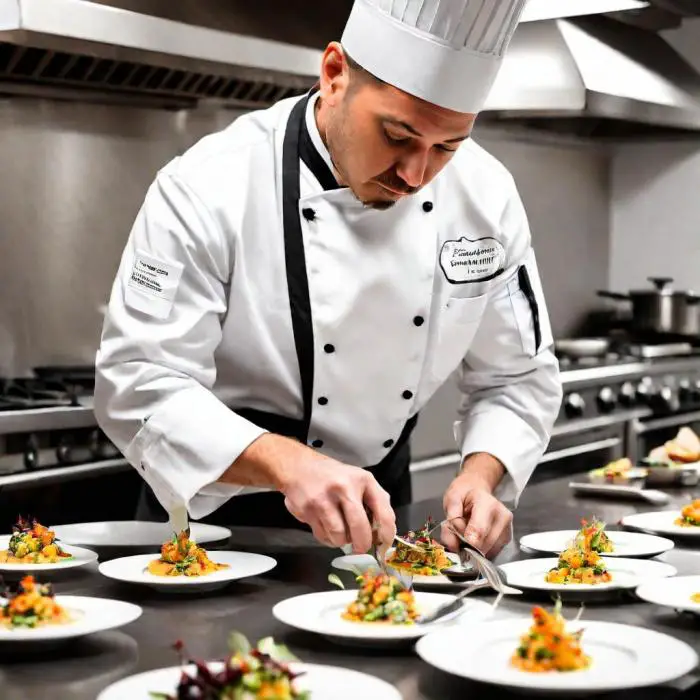
A chef making plating of dishes.
Introduction
Presentation plays a crucial role in the dining experience, with the visual appeal of a dish often influencing our perception of its taste.
Mastering the art of food plating can elevate home-cooked meals to restaurant-quality standards. In this blog post, we explore essential tips and techniques to enhance your plating skills to impress both yourself and your guests.
In culinary competitions, plating takes on an even greater significance. Here’s how plating factors into competition success:
- First Impression: Judges often get just one glimpse of your dish before tasting. Eye-catching plating grabs their attention and sets a positive tone.
- Storytelling on a Plate: Use plating to visually tell the story of your dish. Highlight key ingredients, showcase contrasting textures, and create a sense of balance and harmony.
- Technical Skill: Precise cuts, clean arrangements, and controlled use of sauces demonstrate your technical prowess in the kitchen.
- Creativity and Innovation: Push the boundaries of plating with unique presentations or unexpected elements.
- Cleanliness and Consistency: A spotless plate and consistent presentation across multiple dishes showcase professionalism and attention to detail.
Here are some additional tips for plating in a competition:
- Practice, Practice, Practice: Experiment with different plating styles beforehand to find something that complements your dish and competition theme.
- Know the Rules: Some competitions may have specific plating requirements or limitations. Make sure you understand the rules beforehand.
- Edit ruthlessly: Sometimes, “less is more.” Avoid overcrowding the plate and ensure each element contributes to the overall presentation.
- Think about the Judges: Consider what might impress them. Are they looking for classic elegance or cutting-edge innovation? Tailor your plating style accordingly.
- Time Management: Don’t let plating become an afterthought. Allocate sufficient time to meticulously plate your dishes during the competition.
By focusing on these aspects, you can use plating as a powerful tool to showcase your culinary skills and creativity in a competition.
While presentation is still important in a commercial kitchen, plating considerations differ slightly from competitions. Here’s how plating factors into success in a busy restaurant setting:
- Speed and Efficiency: Plating needs to be done quickly and efficiently without sacrificing quality. Opt for techniques that can be executed rapidly while still achieving a visually appealing result.
- Consistency and Uniformity: Customers expect a consistent dining experience. Strive for uniform portion sizes and plating styles across all orders for the same dish.
- Functionality over Flair: While presentation matters, prioritize practicality. The plate design should allow for easy eating and avoid unnecessary elements that might disrupt the dining experience.
- Menu Suitability: Consider the overall menu and restaurant theme. Upscale establishments might have more elaborate plating, while casual diners may favor simpler presentations.
- Cost-Effectiveness: Be mindful of using excessive garnishes or sauces that inflate food costs.
Here are some additional tips for plating in a commercial kitchen:
- Standardize Plating Techniques: Develop a set of signature plating styles for common dishes that can be easily replicated by your kitchen staff.
- Mise en Place is Key: Even more so in a fast-paced environment, having everything prepped and organized beforehand is crucial for efficient plating.
- Utilize Teamwork: Train your staff on plating techniques and delegate tasks where possible to ensure smooth service during peak hours.
- Presentation with Purpose: Use garnishes strategically to enhance flavor or add pops of color, but avoid purely decorative elements that add cost without value.
By focusing on these points, you can create a plating strategy that balances visual appeal with the practical realities of a commercial kitchen, ensuring a successful and efficient dining experience for your customers.pen_sparktunesharemore_vert
Essential Plating Techniques
The Plate as a Canvas
- Choosing the right plate size and shape is essential to showcase your dish effectively.
- Utilizing the rule of thirds helps achieve balance in your presentation.
- Leaving negative space on the plate enhances the visual impact of the food.
Composition and Balance
- Highlighting the main ingredient draws attention to the star of the dish.
- Playing with colors and textures creates contrast and visual interest.
- Adding height and dimension to the plate makes the dish more visually appealing.
Sauces and Garnishes
- Using sauces strategically, such as drizzles, pools, or borders, adds flavor and visual appeal.
- Selecting appropriate garnishes like edible flowers or herbs enhances taste and aesthetics.
Additional Tips and Considerations
Portion Control and Presentation
- Maintaining appropriate portion sizes ensures a balanced plate.
- Tailoring the plating style to specific occasions, whether casual or formal, enhances the dining experience.
Practice and Inspiration
- Experimenting with different plating styles can help develop your unique aesthetic.
- Finding inspiration from food photos and magazines can spark creativity in your presentation.
Conclusion
Mastering the art of food plating not only enhances the visual appeal of your dishes but also elevates the overall dining experience.
By carefully considering composition, balance, sauces, garnishes, portion control, and practicing different styles, you can impress your guests with professional-looking plates that are as delightful to the eyes as they are to the palate. Start honing your plating skills today and take your culinary creations to the next level!
FAQ: Mastering Food Plating Skills
Q: Why is plating important?
A: Plating is more than just making food look pretty. It can elevate the entire dining experience by:
- Enhancing visual appeal: A well-plated dish is more inviting and appetizing.
- Highlighting flavors and textures: Plating draws attention to key ingredients and creates interesting contrasts.
- Influencing taste perception: Studies show that visual presentation can impact how we taste food.
Q: What are some essential plating techniques?
A: Here are key things to consider:
- The Plate as a Canvas:
- Plate Size & Shape: Choose a plate that complements your dish size and allows for negative space (empty area) for visual impact.
- Rule of Thirds: Imagine dividing the plate into thirds horizontally and vertically. Arrange your food elements at these intersections for a balanced look.
- Composition & Balance:
- Star of the Show: Highlight the main ingredient with its placement and size.
- Color & Texture: Use contrasting colors and textures for visual interest. Think vibrant sauces against green vegetables or crispy elements next to smooth sauces.
- Height & Dimension: Layer ingredients or use props (like spoons or skewers) to create a visually dynamic plate.
- Sauces & Garnishes:
- Sauce Strategy: Use sauces sparingly for accents. Drizzle, pool, or create borders to define elements and add shine.
- Garnishing Genius: Choose garnishes that complement the dish’s flavor profile and add a touch of color or texture. Edible flowers and fresh herbs are popular choices.
Q: Are there other plating considerations?
A: Absolutely!
- Portion Control & Presentation:
- Maintain appropriate portion sizes for the occasion.
- Casual settings can have a more relaxed plating style, while formal events may require a more structured approach.
- Practice & Inspiration:
- Experiment with different plating styles to find what works for you.
- Look for inspiration in food photos online, cookbooks, and magazines.
Q: How can I improve my plating skills?
A: The key is practice! The more you plate, the more comfortable and confident you’ll become. Don’t be afraid to experiment and have fun with it.

